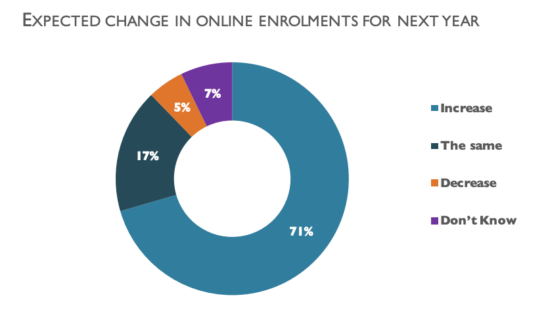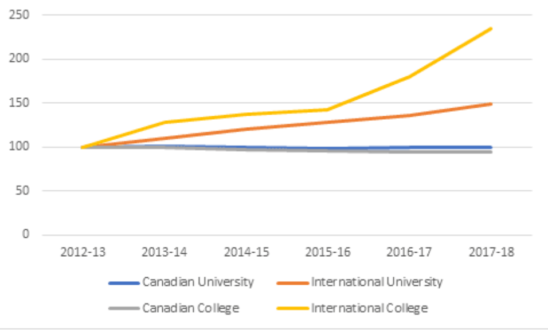
Statistics Canada has published its latest report on student enrolments for the academic year 2017-2018. This coincides with the data from the latest report of the Canadian Digital Learning Research Association (CDLRA), which also covers the academic year 2017-2018.
Results
Statistics Canada reports that:
- there were 2,116,002 overall enrolments
- overall growth was 1.9% from the previous year;
- international students though increased by 15.6%
- Canadian students edged up 0.2% (university students went up by 0.3%, colleges went down by 0.1%)
CDLRA however reported online enrolments as growing by 10% nationally, and nearly all these students were resident in Canada (but not necessarily of Canadian nationality – they could include international students resident in Canada).
Comment
There has been enormous growth in international students in Canadian post-secondary institutions. Usher (2010) reports that international enrolments in Canadian colleges have doubled between 2013-2014 and 2017-18, while domestic enrolments are actually down since 2012-2013 (0.5% in universities and 5% in colleges).

Statistics Canada reports that half of all international students in Canada are from India (22.8%) or China (28.1%). Usher comments:
This may not be a bubble per se, but you can’t blame people for acting like it might be. Cash in while you can. These increases aren’t going to last forever.
On the other hand, online enrolments have been increasing steadily over the last few years, at around 10 per cent per annum. They probably now constitute about 10 per cent of all credit enrolments.
It is not clear what proportion of online enrolments are merely replacing face-to-face class enrolments or represent new students, but demographic factors such as declining numbers in the cohorts completing high school, especially outside the larger metropolitan areas, and increasing demand for lifelong learning due to a volatile job market, are likely to sustain the importance of online learning.
The fragility of the international market is underscored both by larger political tensions as well as by health factors such as the coronovirus. Should the international market suffer a sharp, severe decline, online enrolments will become even more important in sustaining institutional enrolment numbers.
Johnson, N. et al. (2019) Tracking Online Education in Canadian Universities and Colleges: National Survey of Online and Digital Learning 2019 National Report Halifax NS: Canadian Digital Learning Research Association
Statistics Canada (2020) Canadian postsecondary enrolments and graduates, 2017/2018 Ottawa: Statistics Canada
Usher, A. (2020) New Enrolment Data. 2017-18. Finally Higher Education Strategy Associates, February 20









 Dr. Tony Bates is the author of eleven books in the field of online learning and distance education. He has provided consulting services specializing in training in the planning and management of online learning and distance education, working with over 40 organizations in 25 countries. Tony is a Research Associate with Contact North | Contact Nord, Ontario’s Distance Education & Training Network.
Dr. Tony Bates is the author of eleven books in the field of online learning and distance education. He has provided consulting services specializing in training in the planning and management of online learning and distance education, working with over 40 organizations in 25 countries. Tony is a Research Associate with Contact North | Contact Nord, Ontario’s Distance Education & Training Network.


Thank you for this good information, Tony. I’m writing from south of the border (though I’m originally from Canada) and it is interesting to note that international student enrollment fell during the same time period here in the US. I might suggest our loss is your gain and contributing to the increase in Canada. https://www.insidehighered.com/news/2018/11/13/new-international-student-enrollments-continue-decline-us-universities
Online enrollment, in comparison, of US total postsecondary students enrolled exclusively in distance education grew at a much more modest 4.2% from 2016-17 to 2017-2018 ( https://nces.ed.gov/ipeds/search). The growth over the last 7 years is tempered here by the falling enrollments of our large for-profit sector.